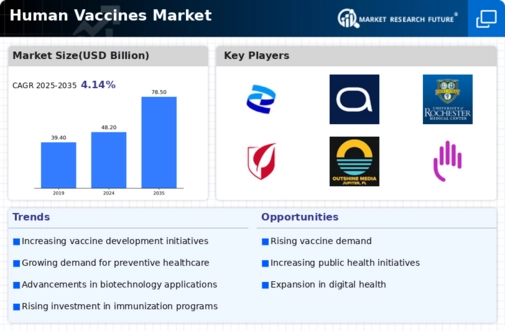Human Vaccines Market Summary
As per Market Research Future Analysis, the Human Vaccines Market is projected to grow significantly, driven by the increasing prevalence of infectious diseases and heightened public awareness of vaccination benefits. The market is expected to expand from 50.22 USD Billion in 2025 to 1.23 USD Billion by 2035, reflecting a CAGR of 4.14% during the forecast period. Key drivers include substantial investments in research and development, public-private partnerships, and advancements in vaccine technology, such as mRNA and personalized vaccines.
Key Market Trends & Highlights
The Global Human Vaccines Market is witnessing transformative trends that are shaping its future.
- Market Size in 2024: 0.67 USD Billion; Expected to reach 1.23 USD Billion by 2035.
- Inactivated vaccines valued at 15.0 USD Billion in 2024, projected to grow to 23.0 USD Billion by 2035.
- Public awareness campaigns have increased immunization coverage for DTP vaccines to over 85% globally.
- North America leads the market with a valuation of 20.0 USD Billion in 2024, expected to grow to 32.0 USD Billion by 2035.
Market Size & Forecast
| 2024 Market Size | USD 0.67 Billion |
| 2035 Market Size | USD 1.23 Billion |
| CAGR (2025-2035) | 5.72% |
Major Players
Key Companies include Pfizer, Merck and Co, AbbVie, Roche, Gilead Sciences, Johnson and Johnson, Bristol Myers Squibb, Novartis, Regeneron Pharmaceuticals, Bayer, Moderna, AstraZeneca, GlaxoSmithKline, Sanofi.






















